Structure of Banks' Balance Sheet and Systemic Risk of Banking Network
The purpose of this paper is to estimate the systemic risk of the banking industry, considering the structure of banks' balance sheets in the interbank money market. To do this research, it develops a network model based on banks' balance-sheet interdependence to analyze how the liquidity risk in a bank moves to other banks. The model shows that liability of the typical bank is an asset in the balance sheet of other banks. When a borrower bank runs out of liquidity and fails to commit to settling its debts in the interbank money markets, lenders run short and reduce their activities in the interbank money market, leaving other banks with liquidity constraints. In fact, a crisis in one bank moves to other banks, which may pose a risk of transmission. In this paper, to measure the systemic risk, the liquidity index in the interbank money market is introduced that is the weighted average of banks' liquidity position. We use daily transactions in the interbank money market from 2013 to 2019 and apply Adrian and Brunnermeier (2016) ∆CoVaR measure and quantile regression to estimate the systemic risk.
The method of collecting data includes document information and record data from interbank money market transactions extracted from the central bank website. In this study, the sample consists of daily transactions of reciprocal deposits of 32 active banks in the interbank money market between November 2013 and July 2019. The interbank money market started its operation in 2009 with two banks. The volume of interbank transactions has increased significantly in the last decade so that in 2019 the volume of transactions is 2.4 times the total liquidity of the economy. The method of data analysis is a quantitative one using E-views software and MATAB software, respectively. To estimate △CoVaR, we first considered two Quantile regression models for 95 and 50 percent Quantiles using ordinary least squares (OLS). All parameters were statistically significant. To estimate the VaR of the stock market and banking system liquidity indices, we first considered the conditional variances of these two indices using the GARCH family models. We estimated different GARCH models and the best model fitted to the data. In the next stage, we used estimated conditional variances to estimate conditional VaR(CoVaR) for two different 95 and 50 percent quantiles based on the estimated parameters of quantile regressions. At the last phase, we calculated △CoVaR based on estimated CoVaR for two quantiles.
The results of the research showed that the null hypothesis of normality of distribution of both stock market index and liquidity status of the interbank money market is rejected based on Jarque-Bera, Andersen-Darling, and Cramér–Von Mises statistics. Dickey-Fuller and Philips-Peron unit root test results showed that both variables are stationary. The results also indicated that the distribution of ∆CoVaR is not normal. Based on the average of ∆CoVaR, in the case of a banking system liquidity crisis, the stock market index will decrease by 2081 units per day on average. The maximum decrease in the stock market is 7088 units in the case of a banking crisis. Concluding: The research result indicates the interdependent structure of banks' balance sheets in the interbank money market. According to the results, the central bank, as a market monitoring authority, should control daily transactions in the interbank money market. It also should take the structure of banks' balance sheet interdependence into consideration in the estimation of the banking system systemic risk.
- حق عضویت دریافتی صرف حمایت از نشریات عضو و نگهداری، تکمیل و توسعه مگیران میشود.
- پرداخت حق اشتراک و دانلود مقالات اجازه بازنشر آن در سایر رسانههای چاپی و دیجیتال را به کاربر نمیدهد.


